Abstract
Immune suppression (immunoprotection) in experimental autoimmune encephalomyelitis (EAE) was studied in (SJL X BALB/c)F1 mice using inocular of mouse spinal cord homogenate (MSCH), or mouse basic protein of myelin (M-BPM), in Freund's incomplete adjuvant (FIA). Such immunization specifically recruited lymphoid cells which markedly suppressed the capacity of effector lymph node cells from appropriately immunized syngeneic mice to transfer adoptively EAE. Suppression was demonstrable with transfer of bone marrow and spleen cells, but not with lymph nodes or thymus cells. Adoptively transferred suppression was maximal when cells were injected 9-30 days after the suppressive injection. Inhibition of EAE by suppressor cells was specific for the relavant antigen BPM, and required viable cells. Treatment of cells with anti-Thy-1 serum before transfer abolished their suppressor activity. After adoptive transfer of suppressor cells into syngeneic recipients subsequently immunized for EAE, there was inhibition of EAE and reduced cell-mediated immune response to BPM as judged by macrophage migration inhibition assays. Hence, in mice at least, immuno-protection against EAE is explicable by recruitment of suppressor T lymphocytes with the dual capacities of inhibiting development of effector T cells after antigenic stimulation, and of blocking their damaging effects on the antigen in the central nervous system.
Full text
PDF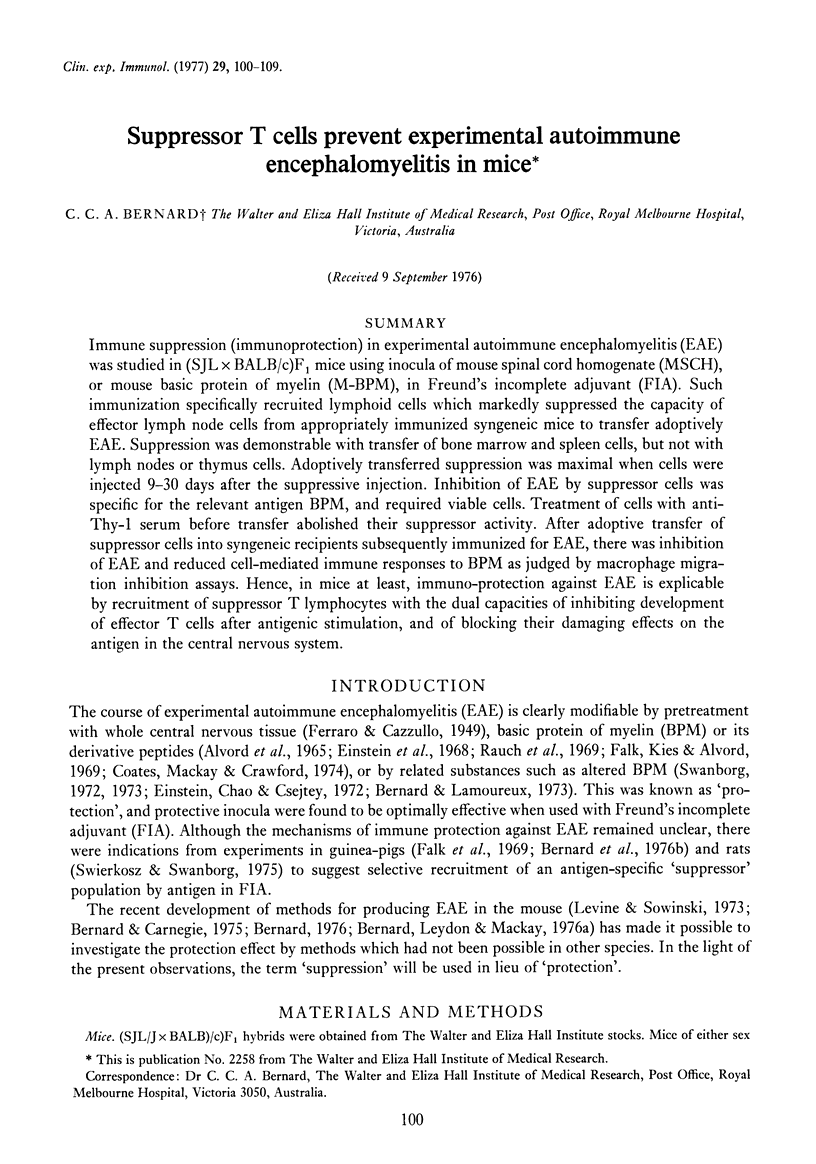

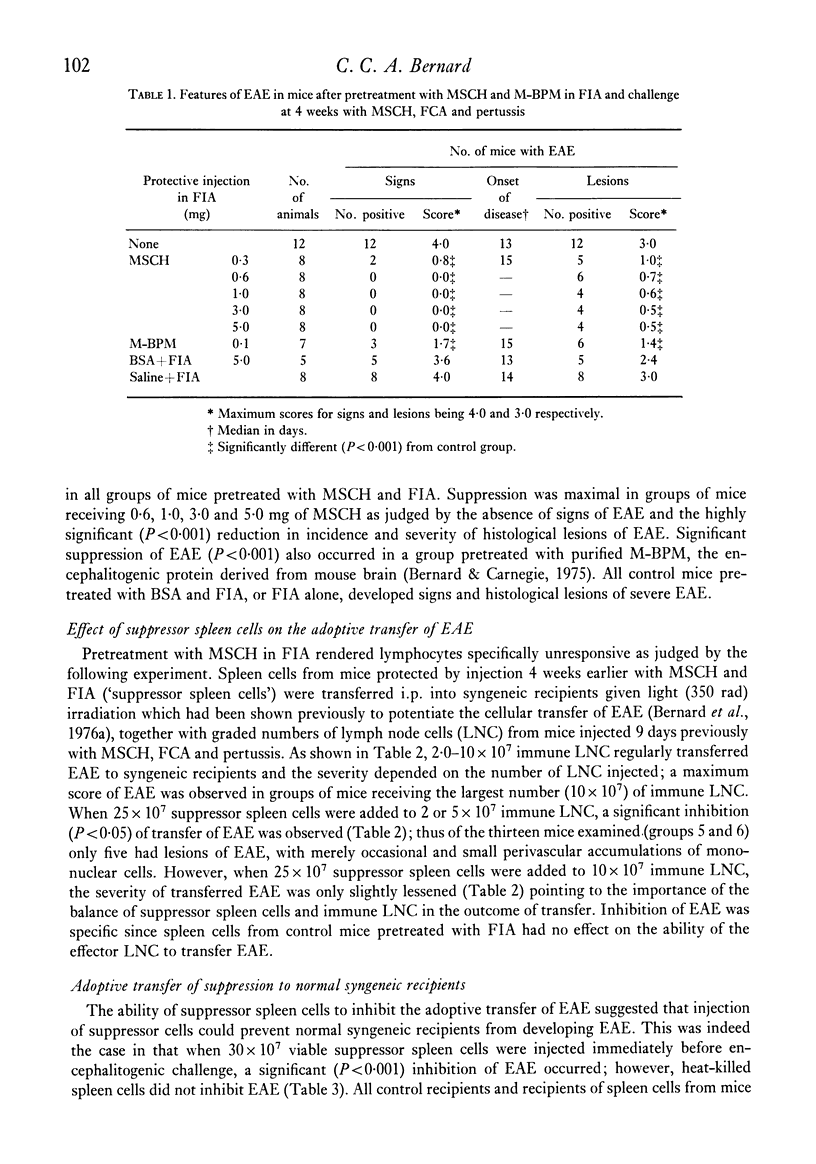
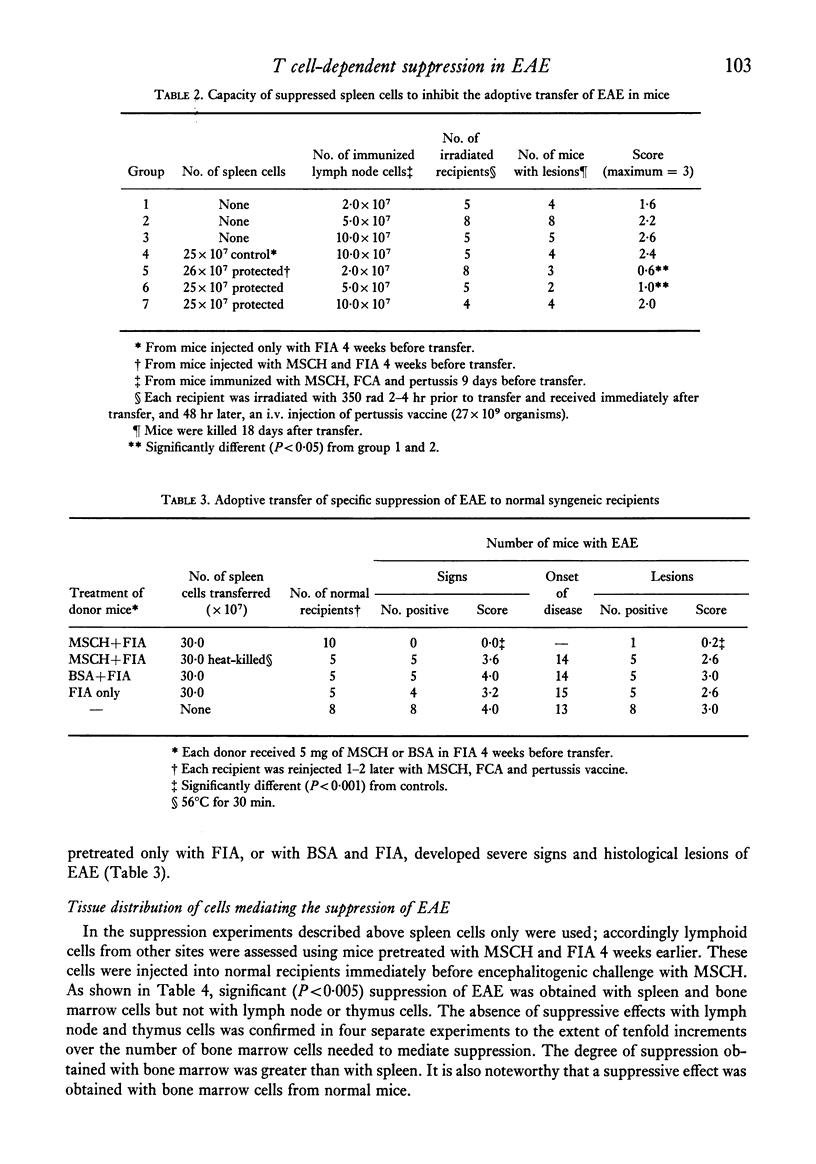
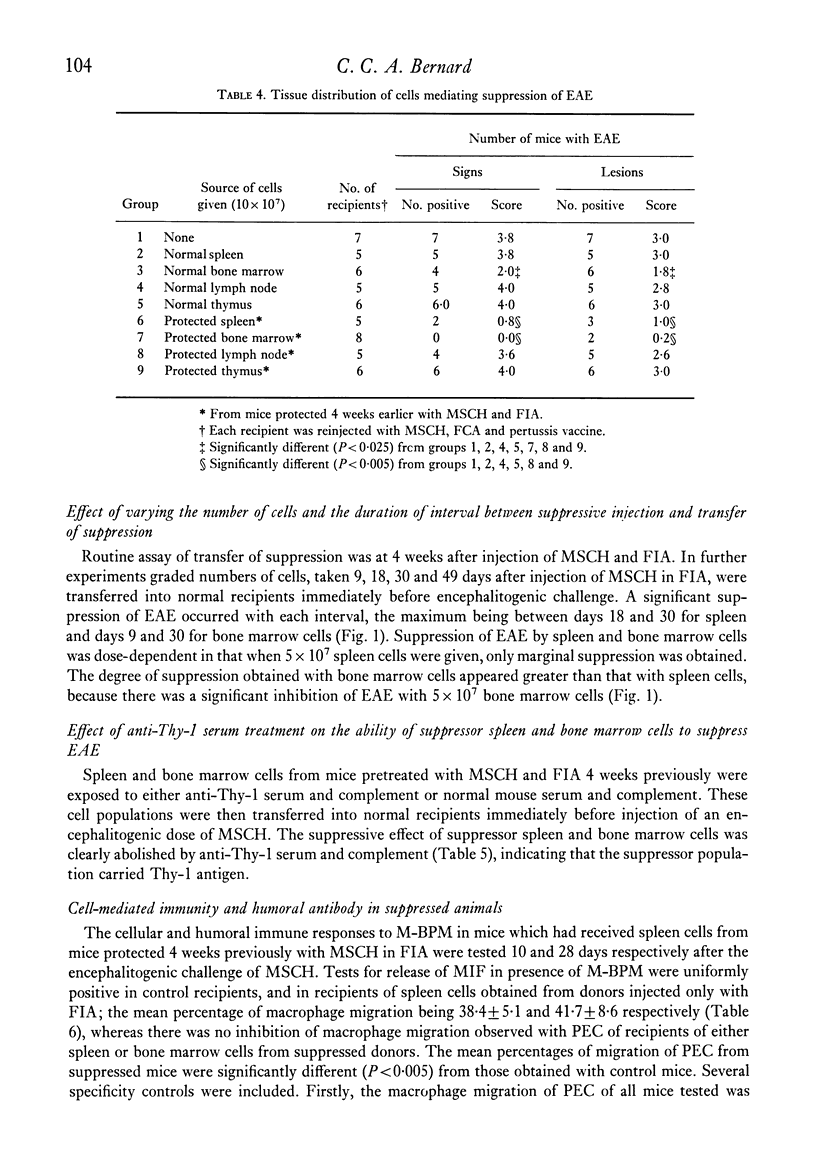
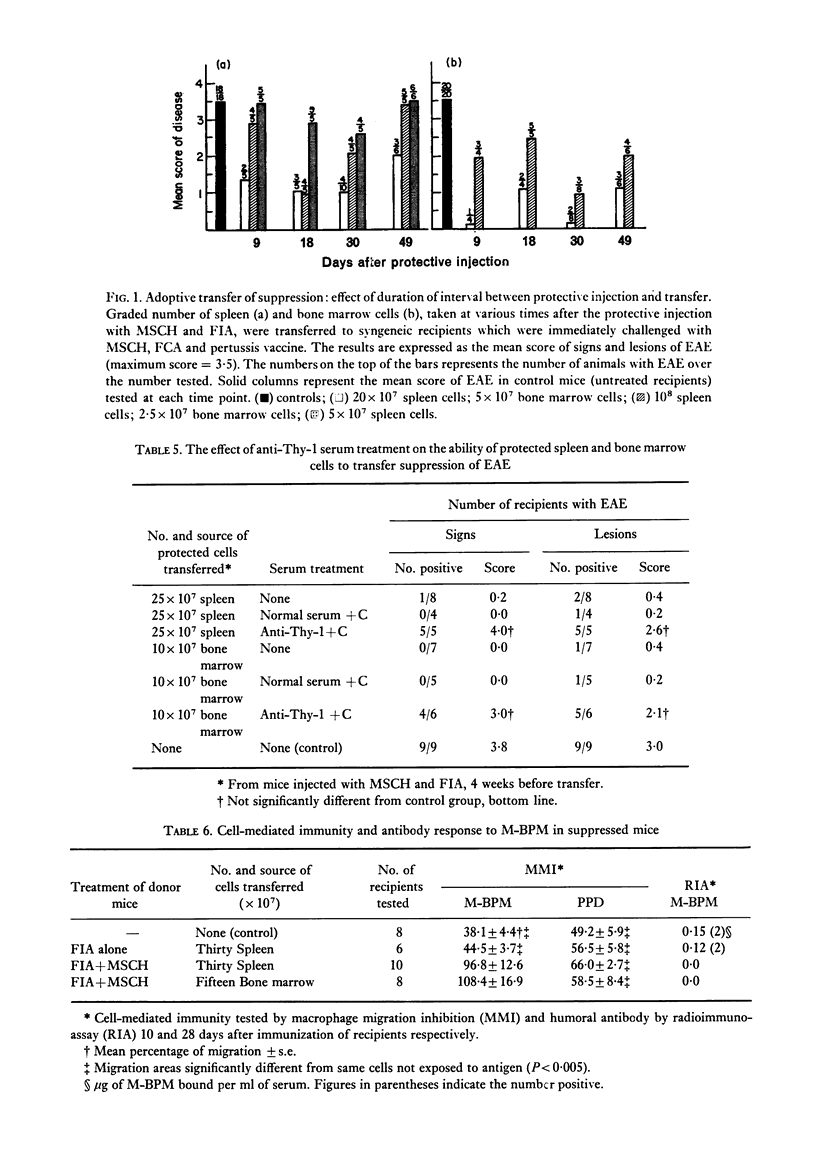
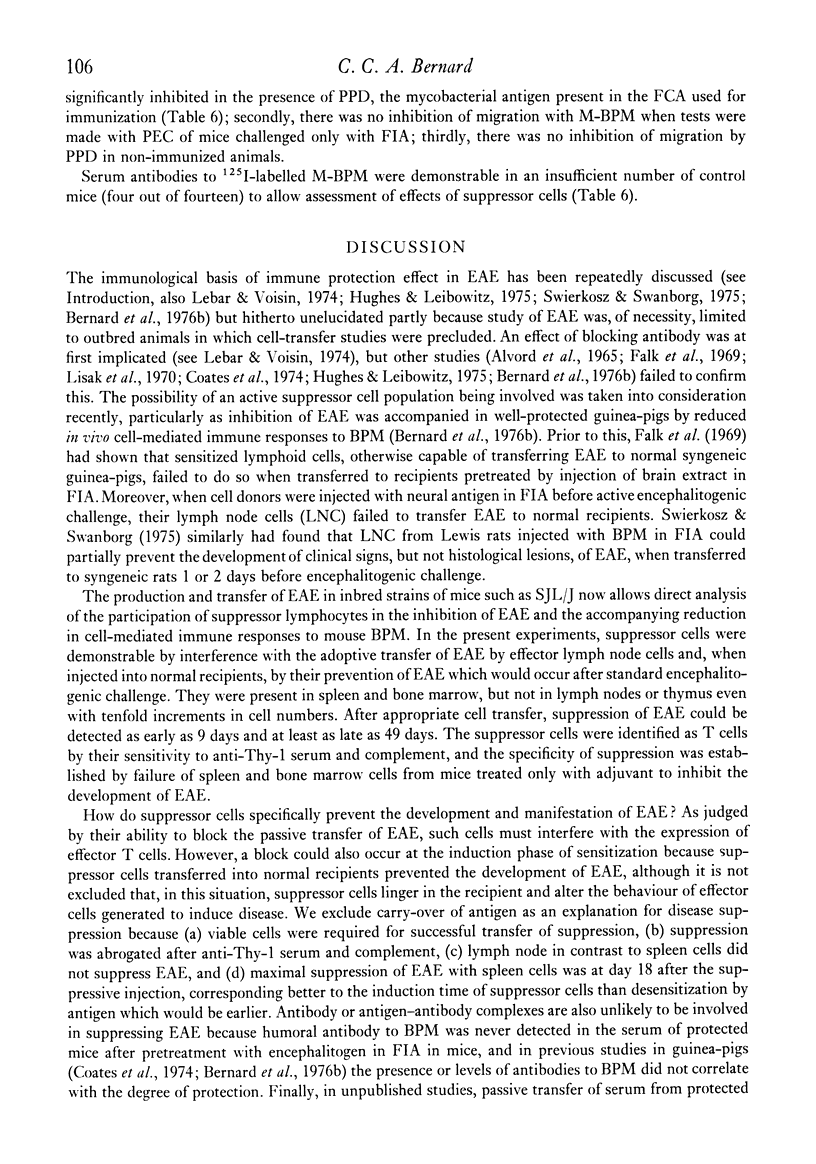
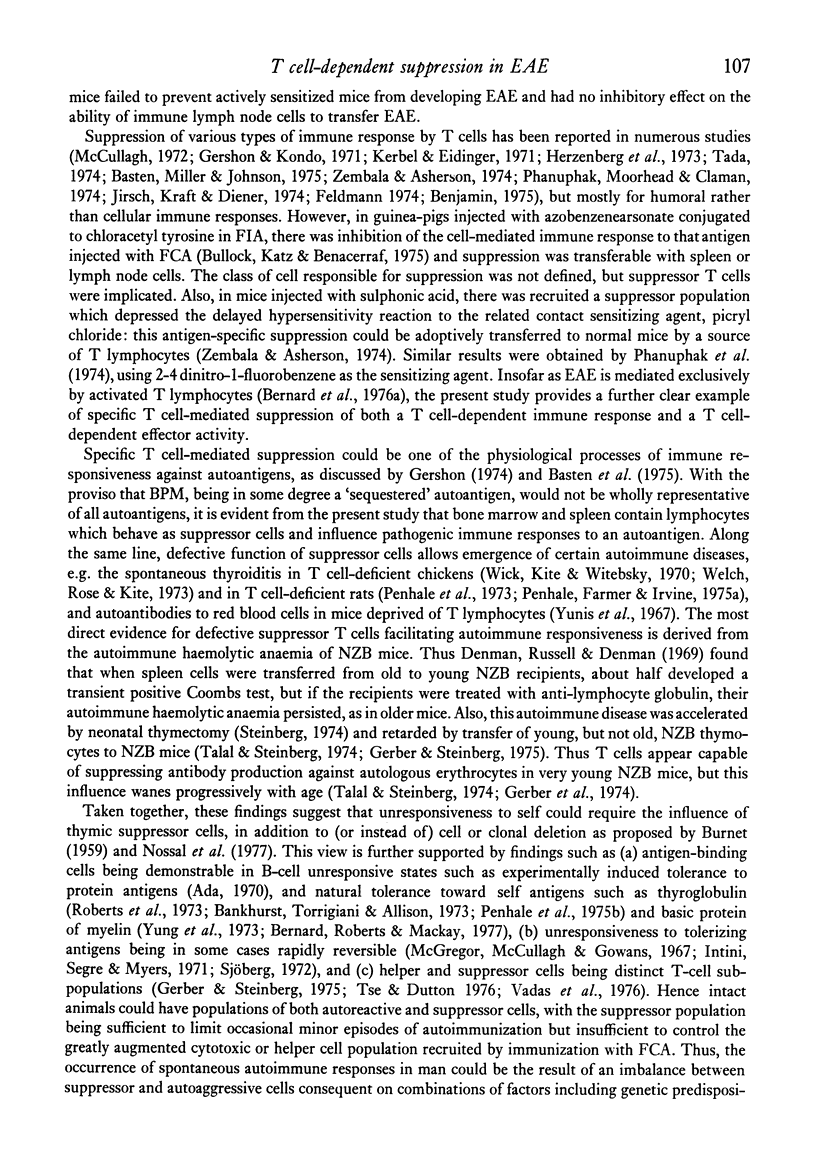
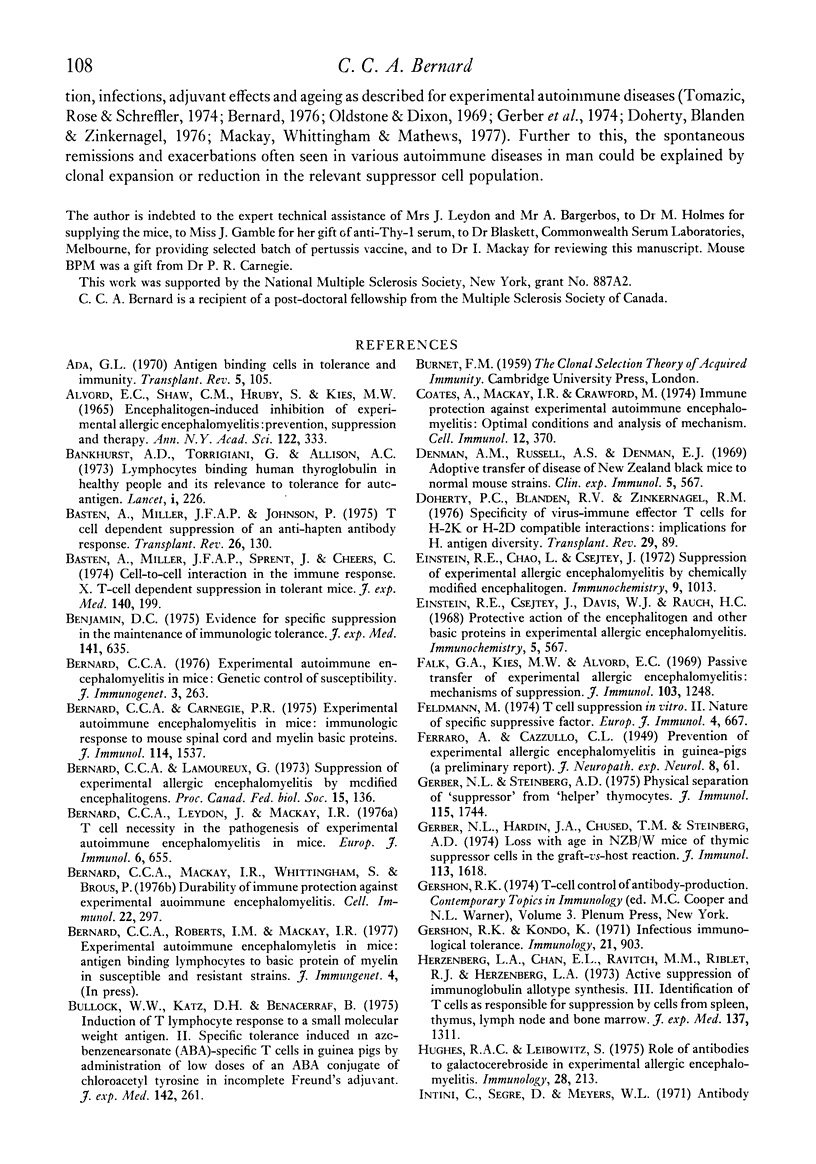
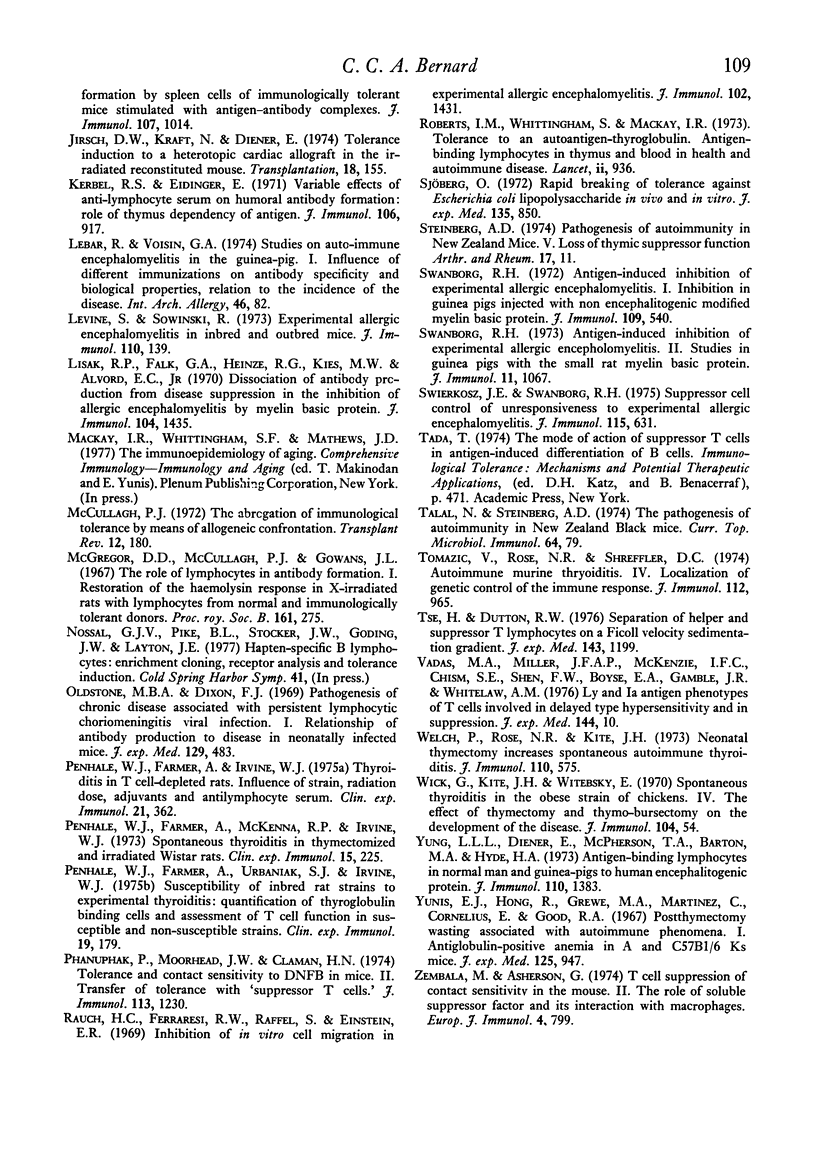
Selected References
These references are in PubMed. This may not be the complete list of references from this article.
- ALVORD E. C., Jr, SHAW C. M., HRUBY S., KIES M. W. ENCEPHALITOGEN-INDUCED INHIBITION OF EXPERIMENTAL ALLERGIC ENCEPHALOMYELITIS: PREVENTION, SUPPRESSION AND THERAPY. Ann N Y Acad Sci. 1965 Mar 31;122:333–345. doi: 10.1111/j.1749-6632.1965.tb20218.x. [DOI] [PubMed] [Google Scholar]
- Ada G. L. Antigen binding cells in tolerance and immunity. Transplant Rev. 1970;5:105–129. doi: 10.1111/j.1600-065x.1970.tb00358.x. [DOI] [PubMed] [Google Scholar]
- Bankhurst A. D., Torrigiani G., Allison A. C. Lymphocytes binding human thyroglobulin in healthy people and its relevance to tolerance for autoantigens. Lancet. 1973 Feb 3;1(7797):226–230. doi: 10.1016/s0140-6736(73)90066-4. [DOI] [PubMed] [Google Scholar]
- Basten A., Miller J. F., Johnson P. T cell-dependent suppression of an anti-hapten antibody response. Transplant Rev. 1975;26:130–169. doi: 10.1111/j.1600-065x.1975.tb00178.x. [DOI] [PubMed] [Google Scholar]
- Basten A., Miller J. F., Sprent J., Cheers C. Cell-to-cell interaction in the immune response. X. T-cell-dependent suppression in tolerant mice. J Exp Med. 1974 Jul 1;140(1):199–217. doi: 10.1084/jem.140.1.199. [DOI] [PMC free article] [PubMed] [Google Scholar]
- Benjamin D. C. Evidence for specific suppression in the maintenance of immunologic tolerance. J Exp Med. 1975 Mar 1;141(3):635–646. doi: 10.1084/jem.141.3.635. [DOI] [PMC free article] [PubMed] [Google Scholar]
- Bernard C. C., Carnegie P. R. Experimental autoimmune encephalomyelitis in mice: immunologic response to mouse spinal cord and myelin basic proteins. J Immunol. 1975 May;114(5):1537–1540. [PubMed] [Google Scholar]
- Bernard C. C. Experimental autoimmune encephalomyelitis in mice: genetic control of susceptibility. J Immunogenet. 1976 Aug;3(4):263–274. doi: 10.1111/j.1744-313x.1976.tb00583.x. [DOI] [PubMed] [Google Scholar]
- Bernard C. C., Leydon J., Mackay I. R. T cell necessity in the pathogenesis of experimental autoimmune encephalomyelitis in mice. Eur J Immunol. 1976 Sep;6(9):655–660. doi: 10.1002/eji.1830060912. [DOI] [PubMed] [Google Scholar]
- Bernard C. C., Mackay I. R., Whittingham S., Brous P. Durability of immune protection against experimental autoimmune encephalomyelitis. Cell Immunol. 1976 Mar 15;22(2):297–310. doi: 10.1016/0008-8749(76)90031-9. [DOI] [PubMed] [Google Scholar]
- Bullock W. W., Katz D. H., Benacerraf B. Induction of T-lymphocyte responses to a small molecular weight antigen. II. specific tolerance induced in azebenzenearsonate (ABA)-specific T cells in Guniea pigs by administration of low doses of an ABA conjugate of chloroacetyl tyrosine in incomplete Freund's adjuvant. J Exp Med. 1975 Aug 1;142(2):261–274. doi: 10.1084/jem.142.2.261. [DOI] [PMC free article] [PubMed] [Google Scholar]
- Coates A., Mackay I. R., Crawford M. Immune protection against experimental autoimmune encephalomyelitis: optimal conditions and analysis of mechanism. Cell Immunol. 1974 Jun;12(3):370–381. doi: 10.1016/0008-8749(74)90093-8. [DOI] [PubMed] [Google Scholar]
- Denman A. M., Russell A. S., Denman E. J. Adoptive transfer of the diseases of New Zealand black mice to normal mouse strains. Clin Exp Immunol. 1969 Dec;5(6):567–595. [PMC free article] [PubMed] [Google Scholar]
- Doherty P. C., Blanden R. V., Zinkernagel R. M. Specificity of virus-immune effector T cells for H-2K or H-2D compatible interactions: implications for H-antigen diversity. Transplant Rev. 1976;29:89–124. doi: 10.1111/j.1600-065x.1976.tb00198.x. [DOI] [PubMed] [Google Scholar]
- Einstein E. R., Chao L. P., Csejtey J. Suppression of experimental allergic encephalomyelitis by chemically modified encephalitogen. Immunochemistry. 1972 Oct;9(10):1013–1019. doi: 10.1016/0019-2791(72)90111-5. [DOI] [PubMed] [Google Scholar]
- Falk G. A., Kies M. W., Alvord E. C., Jr Passive transfer of experimental allergic encephalomyelitis: mechanisms of suppression. J Immunol. 1969 Dec;103(6):1248–1253. [PubMed] [Google Scholar]
- Feldmann M. T cell suppression in vitro. II. Nature of specific suppressive factor. Eur J Immunol. 1974 Oct;4(10):667–674. doi: 10.1002/eji.1830041006. [DOI] [PubMed] [Google Scholar]
- Gerber N. L., Hardin J. A., Chused T. M., Steinberg A. D. Loss with age in NZB-W mice of thymic suppressor cells in the graft-vs-host reaction. J Immunol. 1974 Nov;113(5):1618–1625. [PubMed] [Google Scholar]
- Gerber N. L., Steinberg A. D. Physical separation of "suppressor" from "helper" thymocytes. J Immunol. 1975 Dec;115(6):1744–1745. [PubMed] [Google Scholar]
- Gershon R. K., Kondo K. Infectious immunological tolerance. Immunology. 1971 Dec;21(6):903–914. [PMC free article] [PubMed] [Google Scholar]
- Herzenberg L. A., Chan E. L., Ravitch M. M., Riblet R. J., Herzenberg L. A. Active suppression of immunoglobulin allotype synthesis. 3. Identification of T cells as responsible for suppression by cells from spleen, thymus, lymph node, and bone marrow. J Exp Med. 1973 Jun 1;137(6):1311–1324. doi: 10.1084/jem.137.6.1311. [DOI] [PMC free article] [PubMed] [Google Scholar]
- Hughes R. A., Leibowitz S. Role of antibodies to galactocerebroside in experimental allergic encephalomyelitis. Immunology. 1975 Feb;28(2):213–218. [PMC free article] [PubMed] [Google Scholar]
- Intini C., Segre D., Segre M., Myers W. L. Antibody formation by spleen cells of immunologically tolerant mice stimulated with antigen-antibody complexes. J Immunol. 1971 Oct;107(4):1014–1021. [PubMed] [Google Scholar]
- Jirsch D. W., Kraft N., Diener E. Tolerance induction to a heterotopic cardiac allograft in the irradiated reconstituted mouse. Transplantation. 1974 Aug;18(2):155–162. doi: 10.1097/00007890-197408000-00009. [DOI] [PubMed] [Google Scholar]
- Kerbel R. S., Eidinger D. Variable effects of anti-lymphocyte serum on humoral antibody formation: role of thymus dependency of antigen. J Immunol. 1971 Apr;106(4):917–926. [PubMed] [Google Scholar]
- Lebar R., Voisin G. A. Studies on auto-immune encephalomyelitis in the guinea pig. I. Influence of different immunizations on antibody specificity and biological properties, relation to the incidence of the disease. Int Arch Allergy Appl Immunol. 1974;46(1):82–103. doi: 10.1159/000231115. [DOI] [PubMed] [Google Scholar]
- Levine S., Sowinski R. Experimental allergic encephalomyelitis in inbred and outbred mice. J Immunol. 1973 Jan;110(1):139–143. [PubMed] [Google Scholar]
- Lisak R. P., Falk G. A., Heinze R. G., Kies M. W., Alvord E. C., Jr Dissociation of antibody production from disease suppression in the inhibition of allergic encephalomyelitis by myelin basic protein. J Immunol. 1970 Jun;104(6):1435–1446. [PubMed] [Google Scholar]
- McCullagh P. The abrogation of immunological tolerance by means of allogeneic confrontation. Transplant Rev. 1972;12:180–197. doi: 10.1111/j.1600-065x.1972.tb00056.x. [DOI] [PubMed] [Google Scholar]
- Oldstone M. B., Dixon F. J. Pathogenesis of chronic disease associated with persistent lymphocytic choriomeningitis viral infection. I. Relationship of antibody production to disease in neonatally infected mice. J Exp Med. 1969 Mar 1;129(3):483–505. doi: 10.1084/jem.129.3.483. [DOI] [PMC free article] [PubMed] [Google Scholar]
- Penhale W. J., Farmer A., Irvine W. J. Thyroiditis in T cell-depleted rats. Influence of strain, radiation dose, adjuvants and antilymphocyte serum. Clin Exp Immunol. 1975 Sep;21(3):362–375. [PMC free article] [PubMed] [Google Scholar]
- Penhale W. J., Farmer A., McKenna R. P., Irvine W. J. Spontaneous thyroiditis in thymectomized and irradiated Wistar rats. Clin Exp Immunol. 1973 Oct;15(2):225–236. [PMC free article] [PubMed] [Google Scholar]
- Penhale W. J., Farmer A., Urbaniak S. J., Irvine W. J. Susceptibility of inbred rat strains to experimental thyroiditis: quantitation of thyroglobulin-binding cells and assessment of T-cell function in susceptible and non-susceptible strains. Clin Exp Immunol. 1975 Jan;19(1):179–191. [PMC free article] [PubMed] [Google Scholar]
- Phanupak P., Moorhead J. W., Claman H. N. Tolerance and contact sensitivity to DNFB in mice. 3. Transfer of tolerance with "suppressor T cells". J Immunol. 1974 Oct;113(4):1230–1236. [PubMed] [Google Scholar]
- Rauch H. C., Einstein E. R., Csejtey J., Davis W. J. Protective action of the encephalitogen and other basic proteins in experimental allergic encephalomyelitis. Immunochemistry. 1968 Nov;5(6):567–575. doi: 10.1016/0019-2791(68)90092-x. [DOI] [PubMed] [Google Scholar]
- Rauch H. C., Ferraresi R. W., Raffel S., Einstein E. R. Inhibition of in vitro cell migration in experimental allergic encephalomyelitis. J Immunol. 1969 Jun;102(6):1431–1436. [PubMed] [Google Scholar]
- Roberts I. M., Whittingham S., Mackay I. R. Tolerance to an autoantigen-thyroglobulin. Antigen-binding lymphocytes in thymus and blood in health and autoimmune disease. Lancet. 1973 Oct 27;2(7835):936–940. doi: 10.1016/s0140-6736(73)92598-1. [DOI] [PubMed] [Google Scholar]
- Sjöberg O. Rapid breaking of tolerance against Escherichia coli lipopolysaccharide in vivo and in vitro. J Exp Med. 1972 Apr 1;135(4):850–859. doi: 10.1084/jem.135.4.850. [DOI] [PMC free article] [PubMed] [Google Scholar]
- Swanborg R. H. Antigen-induced inhibition of experimental allergic encephalomyelitis. I. Inhibition in guinea pigs injected with non-encephalitogenic modified myelin basic protein. J Immunol. 1972 Sep;109(3):540–546. [PubMed] [Google Scholar]
- Swanborg R. H. Antigen-induced inhibition of experimental allergic encephalomyelitis. II. Studies in guinea pigs with the small rat myelin basic protein. J Immunol. 1973 Oct;111(4):1067–1070. [PubMed] [Google Scholar]
- Swierkosz J. E., Swanborg R. H. Suppressor cell control of unresponsiveness to experimental allergic encephalomyelitis. J Immunol. 1975 Sep;115(3):631–633. [PubMed] [Google Scholar]
- Talal N., Steinberg A. D. The pathogenesis of autoimmunity in New Zealand black mice. Curr Top Microbiol Immunol. 1974;64(0):79–103. doi: 10.1007/978-3-642-65848-8_3. [DOI] [PubMed] [Google Scholar]
- Tomazic V., Rose N. R., Shreffler D. C. Autoimmune murine thyroiditis. IV. Localization of genetic control of the immune response. J Immunol. 1974 Mar;112(3):965–969. [PubMed] [Google Scholar]
- Tse H., Dutton R. W. Separation of helper and suppressor T lymphocytes on a ficoll velocity sedimentation gradient. J Exp Med. 1976 May 1;143(5):1199–1210. doi: 10.1084/jem.143.5.1199. [DOI] [PMC free article] [PubMed] [Google Scholar]
- Vadas M. A., Miller J. F., McKenzie I. F., Chism S. E., Shen F. W., Boyse E. A., Gamble J. R., Whitelaw A. M. Ly and Ia antigen phenotypes of T cells involved in delayed-type hypersensitivity and in suppression. J Exp Med. 1976 Jul 1;144(1):10–19. doi: 10.1084/jem.144.1.10. [DOI] [PMC free article] [PubMed] [Google Scholar]
- Welch P., Rose N. R., Kite J. H., Jr Neonatal thymectomy increases spontaneous autoimmune thyroiditis. J Immunol. 1973 Feb;110(2):575–577. [PubMed] [Google Scholar]
- Wick G., Kite J. H., Jr, Witebsky E. Spontaneous thyroiditis in the obese strain of chickens. IV. The effect of thymectomy and thymo-bursectomy on the development of the disease. J Immunol. 1970 Jan;104(1):54–62. [PubMed] [Google Scholar]
- Yung L. L., Diener E., McPherson T. A., Barton M. A., Hyde H. A. Antigen-binding lymphocytes in normal man and guinea pig to human encephalitogenic protein. J Immunol. 1973 May;110(5):1383–1387. [PubMed] [Google Scholar]
- Yunis E. J., Hong R., Grewe M. A., Martinez C., Cornelius E., Good R. A. Postthymectomy wasting associated with autoimmune phenomena. I. Antiglobulin-positive anemia in A and C57BL-6 Ks mice. J Exp Med. 1967 May 1;125(5):947–966. doi: 10.1084/jem.125.5.947. [DOI] [PMC free article] [PubMed] [Google Scholar]


